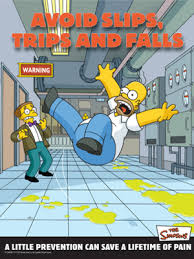| This article originally appeared in the March 2015 issue of Occupational Health & Safety. |
Attentionally Avoiding Traps – and Trips
The takeaway is this is a combo skillset that is neither haphazard nor hereditary; attention control can definitely be improved with the right practices.
When attention slips, so can we. Likely because the mind leads the body. Attention is much more than solely “mental” – it drives what our body does. Every action begins with our brain sending signals to activate specific muscles for accomplishing selected tasks such as reaching, grabbing, lifting, or walking. In other words, what we see + what we intend + what we direct all lead to what we actually do. Understanding this, internal martial arts masters instruct students to initially focus on affecting attacker’s perceptions: “First move their mind in order to move their body.” Similarly, skid control trainers remind drivers to “Stare, don’t steer, into a turn.” That where you focus is where you’ll wind up heading (termed “target fixation” in aviation.)
Turning attention toward preventing the persistent problems of slips, trips, and falls, I’m sure you’ve seen similar statistics over and again – they don’t seem to change much. According to the U.S. Bureau of Labor Statistics, there were 223,700 cases involving falls, slips, trips in 2012. But how many more went unreported? Off the record, numerous corporate Safety pros reveal these are among the most underreported incidents. And what about those slip or trip injuries that are coded differently because they result in strains and sprains or are “bodily reaction” (basically a slip/trip/balance issue that didn’t result in impact)?
Further, no surprise, this issue affects companies wherever people walk, worldwide. For example, Great Britain’s Health & Safety Executive reported that in 2013-14, falls and slips & trips accounted for over a third (35 percent) of all employee injuries.
Standard responses to these persistent problems are good and all and have undoubtedly managed to keep slips/trips/falls from becoming worse. But even with best mats/signs/flooring/reminders and footwear, the level of these injuries has still clearly been holding steady at a dull roar. And, regrettably, there are some convinced nothing else could be done, that these injuries are inevitable and ultimately unpreventable. In counterpoint, strongest leaders know that all problems have solutions, even if they haven’t yet discovered them.
Consider another approach: placing people more in control of their own safety by transferring to them the right mental and physical skills. This has shown to consistently prevent slips/trips/falls; it begins, as many things do, with attention.
Performance psychologist Robert Nideffer sees attention as having two dimensions: width and direction. Width means its field – what you see and/or hear or smell or feel – can be narrow or wide. Direction refers to where you focus, either internally (thoughts, recalling procedures, dwelling on nagging pain in part of body, etc.) or externally (objects strewn on the ground ahead and more). We may be too narrowly focused to see that we could have walked around that slippery area or trying to be so externally aware that we didn’t notice we were holding our breath (raising tension and sapping balance) when traversing an at-risk surface. I’ve found that a high-level ability to prevent slips, trips, and falls relies on being able to combine and shift between attentional fields, appropriately scanning for surface changes or obstacles with a wide/external view, then zooming in with a narrow external view – to note, for example, how elevator floor and threshold are at slightly different heights – while maintaining a wide/internal sense of balance.
Regrettably, I can’t transfer personal techniques for preventing slips/trips/falls in writing (or video) any more than can I try to help you experience the taste of a spice you’ve not yet tried. However, rest assured it’s readily possible to help all kinds of workers of all ages learn how to better keep their balance while on the move and significantly reduce injuries from slips, trips and falls. But this has to emanate from leaders opening their mental vistas to provide for workers’ learning the right skills for becoming more in mental and physical control of their own safety. Ultimately, real attention to highest-level Safety begins with leaders
The Nano-Grip floor safety system of nonslip treatment and aftercare relieves the brain of the complications which arise from encountering a slippery surface while traversing an otherwise safe surface. One simple application renders mineral floors such as tile and marble less slippery wet than dry. For a referral to a local Nano-Grip applicator to have your facility evaluated call 855-687-0976 .

